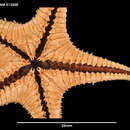en
names in breadcrumbs


“Ctenodiscus procurator, n. sp. (Pl. XXX. figs. 7-12).
This form has so many points of close resemblance to the North-Atlantic Ctenodiscus corniculatus that examples might be selected which at first sight would easily be mistaken for that species. A number of small differences, however, present themselves when a large series is examined, which appear sufficiently constant to warrant the recognition of this form as a distinct species. Under these circumstances the description of Ctenodiscus procurator will probably he most intelligible if it takes the form of a comparative review of the characters of this species in relation to those of the two previously known species of Ctenodiscus, viz., Ctenodiscus corniculatus of the North Atlantic, and Ctenodiscus autralis, Lütken, from the East of Patagonia.
When these three species are compared inter se it is evident that in many respects Ctenodiscus corniculatus, though so widely separated geographically, appears to occupy an intermediate classificatory position between Ctenodiscus australis and Ctenodiscus procurator, which inhabit the eastern and western sides respectively of South America. In Ctenodiscus procurator the rays are generally a trifle longer, and, even when not actually so, have at least that appearance in consequence of being slightly narrower at the base and more attenuate and pointed outwardly. The abactinal area is plane, its union with the lateral wall, especially in the region of the disk and the base of the rays, forming a sharp angle in consequence of the rapid adoral slope of the whole lateral wall; the supero-marginal plates being also affected in the majority of cases. This feature at once strikes the eye in comparison with the usually vertical and actinally well-rounded margin of Ctenodiscus corniculatus and the thick and tumid one of Ctenodiscus australis.
The paxillae of the abactinal area are small and crowded, similar to those in Ctenodiscus corniculatus. The madreporiform body is distinct and not hidden by paxillae as in Ctenodiscus australis. The marginal plates appear to be invariably rather more numerous than in Ctenodiscus corniculatus, and consequently still more so than in Ctenodiscus australis;—for example, in a specimen of Ctenodiscus procurator, measuring R = 28.5 mm., there are eighteen supero-marginal plates counting from the median interradial line to the extremity; whereas in Ctenodiscus corniculatus of exactly the same radial dimensions (R 28.5 mm.) there are only fifteen. Ctenodiscus corniculatus, with R = 27 mm., has fourteen supero-marginal plates; Ctenodiscus procurator, with R = 27 mm., has seventeen. Ctenodiscus procurator appears to have generally one or more spines less on the adambulacral plates than in Ctenodiscus corniculatus, three only being actually marginal or furrow spines, and a fourth standing backward and on the actinal surface of the plate at the aboral end. Very rarely indeed are four furrow spines present; whereas four and five are general in Ctenodiscus corniculatus.
From the foregoing remarks it will be seen that Ctenodiscus procurator is much more closely allied to the North-Atlantic Ctenodiscus corniculatus than to the comparatively neighbouring form Ctenodiscus australis, from which it is readily distinguished. On the other hand the individual points of difference between the Chilian and the Northern forms are small and trifling, but when taken as a whole may be regarded as sufficient to differentiate them specifically, especially when the constancy of the characters in question and the widely separated geographical position of the two forms are taken into account.
Colour in alcohol, a bleached yellowish white.
Localities.—Station 303. Off the western coast of South America, off the Chonos Archipelago. December 30, 1875. Lat. 45° 31' 0" S., long. 78° 9' 0" W. Depth 1325 fathoms. Blue mud. Bottom temperature 36.0° Fahr.; surface temperature 54.8° Fahr.
Station 306. In the Messier Channel, between Wellington Island and the west coast of Chili. January 2, 1876. Lat. 48° 17' 0" S., long. 74° 33'0" W. Depth 565 fathoms. Blue mud. Surface temperature 57.0° Fahr.
Station 307. Between Wellington Island and the west coast of Chili, off Port Grappler. January 4, 1876. Lat. 49° 24'. 30" S., long. 74° 23' 30" W. Depth 140 fathoms. Blue mud. Surface temperature 53.0° Fahr.
Station 309. Off Puerto Buono. January 8, 1876. Lat. 50' 56' 0" S., long. 74° 15' 0" W. Depth 40 fathoms. Blue mud. Bottom temperature 47.0° Fahr.; surface temperature 50.5° Fahr.
Station 311. Off the entrance to Smyth Channel. January 11, 1876. Lat. 52° 45' 30" S., long. 73' 46' 0" W. Depth 245 fathoms. Blue mud. Bottom temperature 46.0° Fahr.; surface temperature 50.0° Fahr.”
(Sladen, 1889: 173-174)